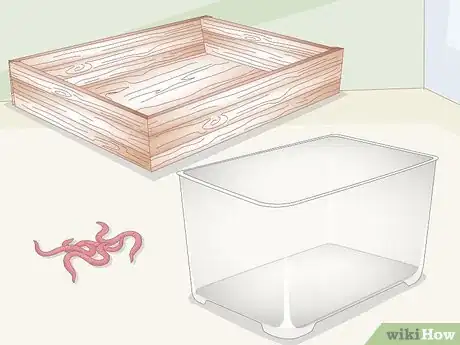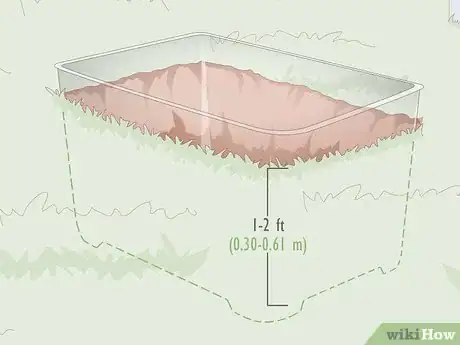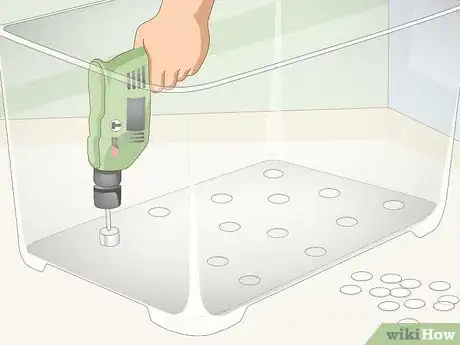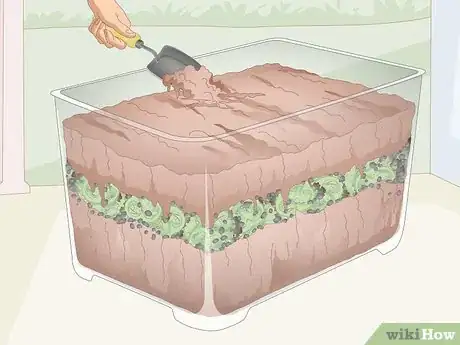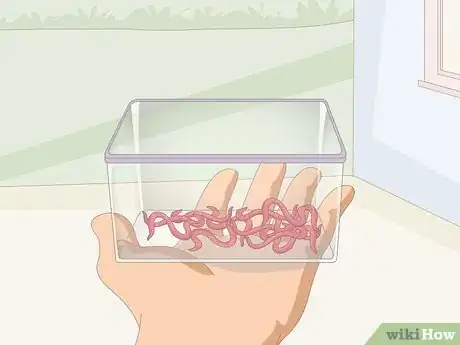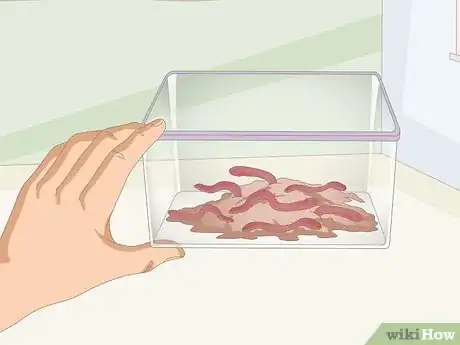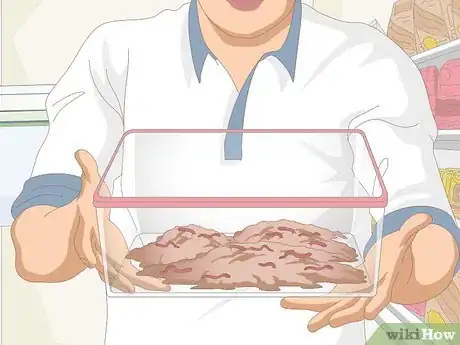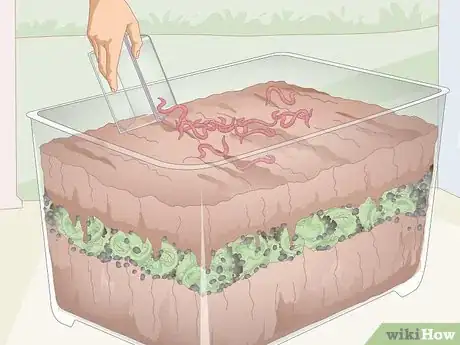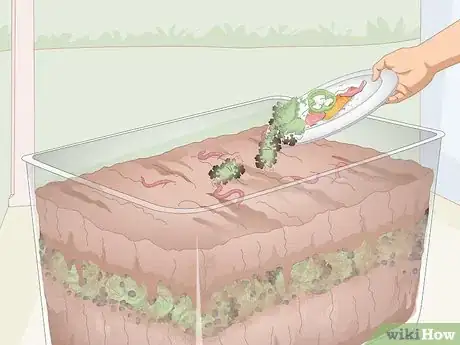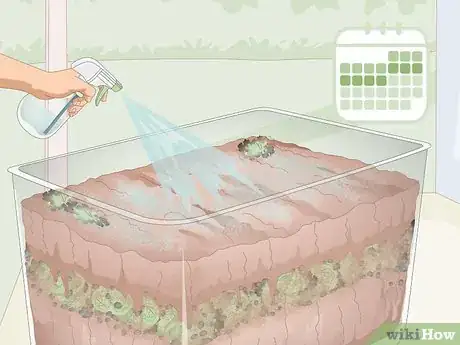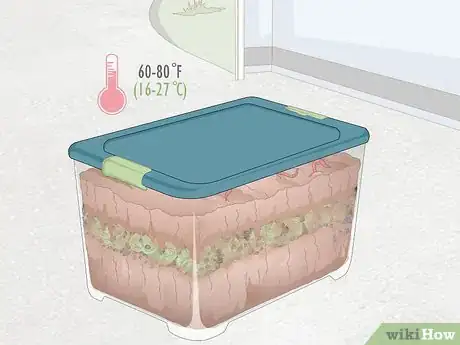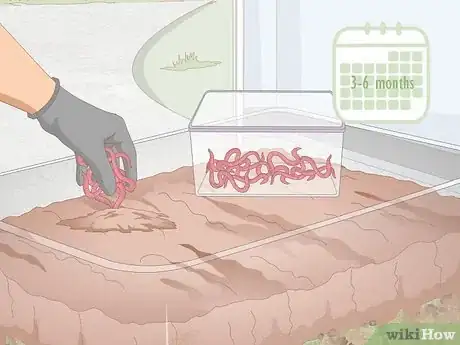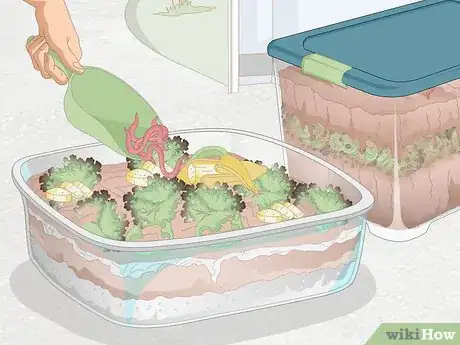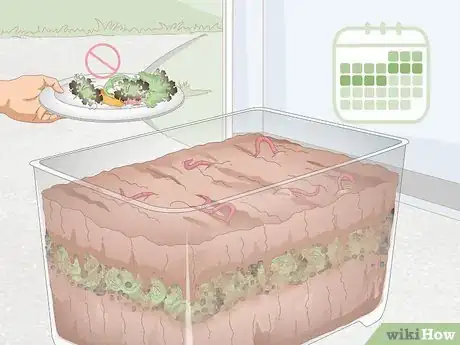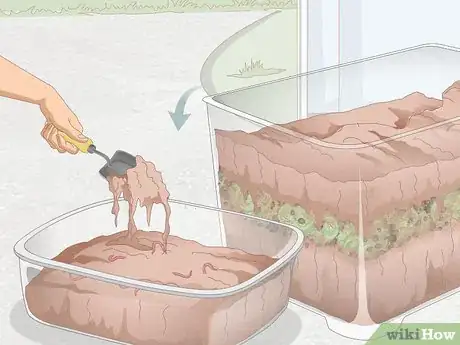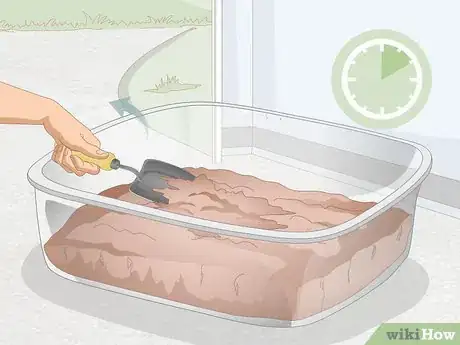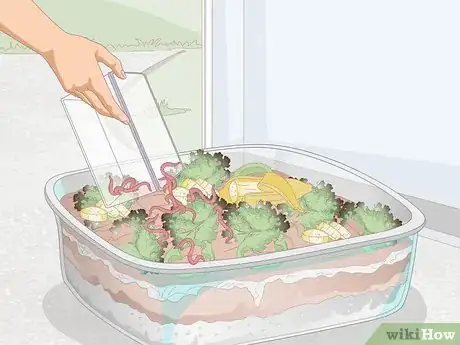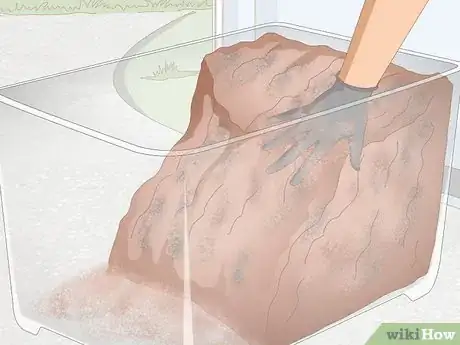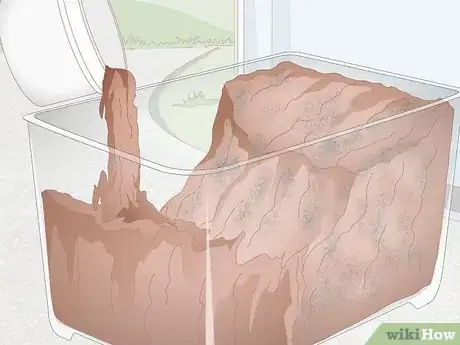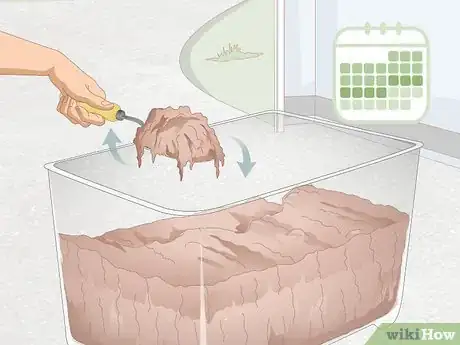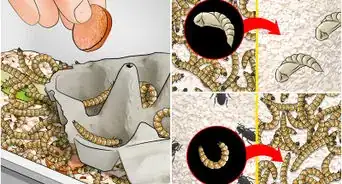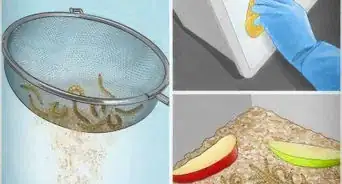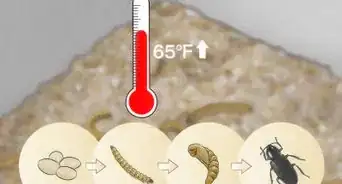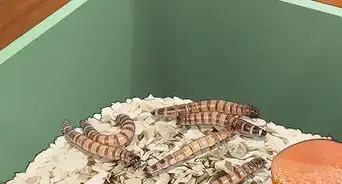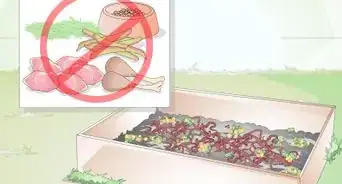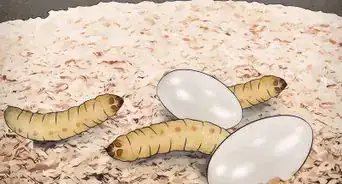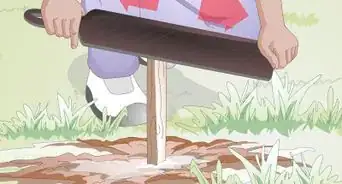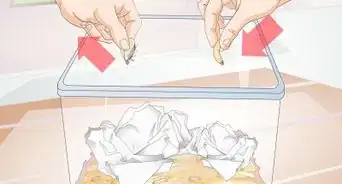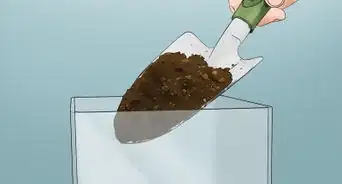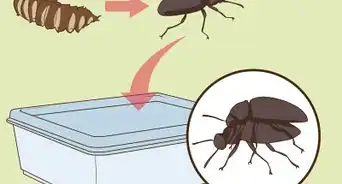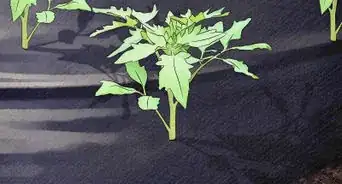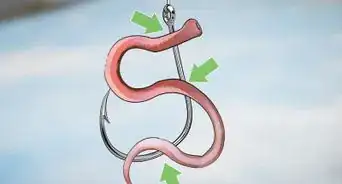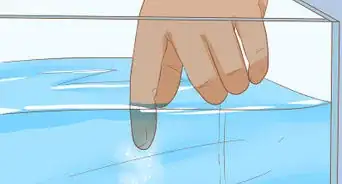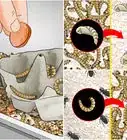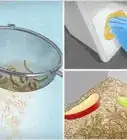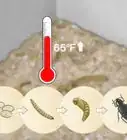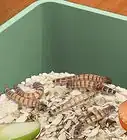This article was co-authored by wikiHow staff writer, Eric McClure. Eric McClure is an editing fellow at wikiHow where he has been editing, researching, and creating content since 2019. A former educator and poet, his work has appeared in Carcinogenic Poetry, Shot Glass Journal, Prairie Margins, and The Rusty Nail. His digital chapbook, The Internet, was also published in TL;DR Magazine. He was the winner of the Paul Carroll award for outstanding achievement in creative writing in 2014, and he was a featured reader at the Poetry Foundation’s Open Door Reading Series in 2015. Eric holds a BA in English from the University of Illinois at Chicago, and an MEd in secondary education from DePaul University.
This article has been viewed 54,166 times.
Learn more...
Breeding worms is a fantastic way to save money on bait if you’re a fan of fishing. They’re also an excellent way to get rid of food waste and paper organically. To breed worms, set up a plastic or wood bin with drainage holes at the bottom. Fill it with soil and compost bedding. Then, add your worms and feed them food scraps, paper, or manure once a week. After 3-6 months, harvest your worms by separating the soil and adding half of the worms to a new container.
Steps
Setting up Your Habitat
-
1Get a small plastic or wood box to house your worms inside. Worms won’t suffer from too much space, but if your container is too big it may be hard to find your worms when you want them. Get a container that is at least 3 ft (91 cm) wide for every 2 lb (0.91 kg) of worms that you want to house. Your container must be at least 2 ft (61 cm) long and 2 ft (61 cm) deep.[1]
- Plastic is the best option for your box since it’s easy to care for. You also can use wood if you’d like though. If you use wood, don’t get chemically-treated lumber.
- If you’re raising worms for compost, the more space that you have the better.
- Your container must have a lid to keep the worms inside and any predators out.
-
2Embed a bin without a bottom outside, 1–2 ft (0.30–0.61 m) in the ground. If you want to store your worms outside, you can cut the bottom out of a plastic bin with a utility knife. Bury it 1–2 ft (0.30–0.61 m) into the ground outside under a canopy or cover. The worms won’t leave if you feed them consistently and keep it warm. You will have to deal with predators though, so keep a heavy lid on top of your worms to keep foxes, birds, or rodents out.[2]
- Worms need darkness to successfully breed, so get a bin with opaque sides and place it under an overhang, roof, or canopy.
- Worms need the temperature to be at least 60 °F (16 °C). Do not store your worms outside if you live in an area with a long or frigid winter.
Advertisement -
3Drill 12-18 holes in the bottom of the bin for drainage. Use a drill or screw to puncture 12-18 holes in the bottom of your bin based on the size of the container. Make each hole at least 1 in (2.5 cm) in diameter to ensure that moisture drains properly and that the soil is exposed to air. Don’t worry about your worms crawling out; if you feed them regularly and keep the temperature warm, the worms won’t have an incentive to go anywhere else.[3]
- You do not need to drill drainage holes if your bin is embedded in the ground outside.
Tip: Many breeders keep the worm box in a tray or pan with a large lip so that if any worms do get out, you can simply put them back where they belong.
-
4Fill your box with organic soil and compost bedding. Start by filling the bottom of your habitat with organic soil. Spread the soil around as you pour it and don’t compact it. When you get within 10–12 in (25–30 cm) from the rim of the container, add a layer of manure, leaves, paper, or salt-free food waste. Then, continue adding soil until you’ve covered the compost layer with at least 6 in (15 cm) of soil.[4]
- The worms will use the layer of compost as their building and bedding material. You don’t need to replace this layer. When you feed the worms, they’ll naturally replace it themselves. Over time, they will break it down into a rich soil that can be used as fertilizer.
- The pH level of the soil must be between 6.8 and 7.2. The pH level is listed on a bag of soil. If you want to test it regularly, buy a digital pH probe and stick it into the soil.[5]
Getting Your Worms
-
1Purchase red worms if you want to use them for composting. Red worms are the best choice if you want to raise worms for composting. They eat a lot and they reproduce easily. If you’re buying red worms for composting, buy 2 pounds (0.91 kg) of worms for every 1 lb (0.45 kg) of garbage that your household creates every day.[6]
- Red worms are also known as red wigglers. Some breeders market larger red worms as wigglers, but they’re basically the same thing.
- Red worms are a type of manure worm. Manure worms are known for their ability to eat organic matter.
- Using worms for composting is known as vermicomposting.
-
2Go with nightcrawlers if you want to use the worms as fish bait. Nightcrawlers, also known as earthworms, are the standard worm that most people see on the side of the road after it rains. They’re larger than red worms, which makes them better fish bait. They do tend to breed slower than red worms though. Buy any amount of nightcrawlers to raise for fishing.[7]
- Field worms are another type of worm that look similar to nightcrawlers. However, they don’t make better bait than nightcrawlers and they’re harder to breed.
Tip: If you are trying to raise bait for smaller fish, nightcrawlers may actually be too big. You can always use red worms as bait if you want.
-
3Buy your worms from a reputable worm dealer. Worm breeders sell their worms to be used as fishing bait or compost worms. Find a worm dealer online near you or ask your fishing buddies if they have any recommendations.[8]
- It can be hard to figure out if you’re getting healthy worms from a good source since worms don’t really communicate their health in any visible way. The good news is that they’re cheap, so if you get a bad batch, you can always try again with a different buyer.
- You can find earthworms and collect them on your own if you’d like. They commonly come to the surface of the soil after it rains. Red worms are much harder to find in the wild, but you can find them under heaps of leaves and in compost piles.
-
4Add your worms to the habitat. To start breeding your worms, add them to the top of the soil. Close the lid and leave them alone for at least 24 hours to give them time to burrow and find the compost layer.[9]
Maintaining Your Worms
-
1Feed your worms roughly once a week to keep them healthy. Worms can eat animal manure, food scraps, shredded paper, or cardboard. To start, give the worms 2–3 lb (0.91–1.36 kg) of food for every 1 lb (0.45 kg) of worms that you’ve bought. After 12-24 hours of feeding your worms, check the worms to see if they’re eating it. If the worms are dying, remove it. Monitor how long it takes them to consume the food you’ve given them. Adjust the amount of food you give them in the future so that it takes them roughly 1 week to eat all of the food.[10]
- The feeding cycle is incredibly important when it comes time to harvest your worms. If they aren’t on a fixed cycle where the worms get food on a specific day, it will be harder to harvest them. The worms will naturally move towards the top of the soil on feeding day and this will help you remove some of them when it comes time to expand your collection.
- If worms die after feeding them, remove whatever food you gave them and try a different feeding material. If you feed them food waste, make sure that it’s low in salt. Sodium can kill your worms.
Tip: There is no right or wrong amount of food to give your worms. The goal is to get your worms on a 1 week cycle where the worms are given food on a specific day. The worms must eat all of the food before 6 days pass. Adjust the amount you feed them as you figure out how much food they eat and how quickly they eat it. This can be a trial and error process to figure out how much to feed the worms.
-
2Mist the soil 1-2 times a week to keep it damp. Worms are the happiest when there’s a little bit of moisture in their soil. To keep your worms happy, fill a spray bottle with tap water and mist the top of the soil 1-2 times a week as needed. For each misting, spray the top of the soil 5-6 times to add a layer of moisture. Be careful not to soak the soil through, though; worms can drown if you add too much water.[11]
- If you see the worms coming to the top of the soil when you check them 1 day after the misting, you’re adding too much water.
-
3Keep the worms in the dark to keep them happy. Worms are nocturnal and will actively avoid sunlight. To keep your worms happy and healthy, keep them in low-light conditions as often as you can. It’s okay to turn the light on when going to inspect their habitat, and you won’t harm them if they get a few minutes of light, but they may start dying if you leave them under a light for more than 6-7 hours.[12]
- If you store your worms outside, put them under a canopy or overhang to keep them in the shade for most of the day.
-
4Maintain a temperature of 60–80 °F (16–27 °C) to promote breeding. Worms do no not do well in the cold, and will die if they’re exposed to low temperatures. To keep the worms content and promote reproduction, keep the temperature in the room between 60–80 °F (16–27 °C). Either keep your heating turned on, or store them somewhere that’s consistently warm.[13]
- If you can’t bring the worms inside in the winter and it gets cold where you live, get a heat lamp and wire cage. Set the habitat inside of the wire cage and set the heat lamp on top to keep the worms warm.
Harvesting Your Worms
-
1Harvest your worms after 3-6 months of feeding. After you’ve consistently fed the worms every week for 3-6 months, they’ll have had enough time to reproduce and grow. Harvesting the worms involves replacing the soil and creating a new habitat for your excess worms. If you harvest your worms before 3 months have passed, you’ll be removing worms before the infant worms have had time to mature.[14]
- Worms take roughly 2 months to lay cocoons and hatch infantile worms. The new worms won’t grow to their mature size for at least another month after they’ve hatched.
- If you don’t see more worms than you normally do when you go to feed them, the infantile worms are likely not grown yet. Check them again in a month.
- Harvesting the worms allows you to thin their population out, which will keep them happy and healthy. It will also encourage the worms to continue breeding.
-
2Prepare a second habitat for the expanded population of worms. If you’re not going fishing with your worms and want to expand your population, you’ll need a second habitat to store your worms. If your worm population has grown, it’s a sign that your habitat was well-made. Create a second habitat that is identical to the first. Add your soil and a layer of compost 6 inches (15 cm) below the surface.[15]
Tip: If your bins ever get extremely overpopulated and you don’t want or need the excess worms, you can always put some of them outside in the soil. The worms will burrow and find a new habitat on their own.
-
3Stop adding food 2 weeks before you want to harvest. Stop your feeding cycle 2 weeks before you want to harvest your worms. This will encourage the worms to come to the upper layers of the soil, which will make it easier for you to harvest them.[16]
-
4Scoop the top layer of soil into a separate container. Get a separate container roughly 1/2 the size of the habitat. This should be a plastic or rubber bin with no holes at the bottom. Set it up next to your worm habitat. Turn a bright light on, and gently scoop the soil into the bin with a hand scooper. Continue scooping soil until you’ve filled the rubber or plastic bin with the top half of your soil.[17]
- Scoop up the compost layer along with the soil.
- With the light on, your worms will start to burrow into the deeper layers of the soil. You’ll scoop out roughly half of the worms that don’t make it all the way to the bottom half of the soil when you turn the light on.
- If your collection is really large, you can use a shovel instead of a scooper.
-
5Remove layers from your new bin in 10-minute increments. Leave the light on and set your new bin under it for 10 minutes to give the worms time to burrow deeper into the soil. After 10 minutes, use your scooper to remove the top 2–3 inches (5.1–7.6 cm) of your soil. Then, wait another 10 minutes and repeat this process. Continue doing this until almost all of the soil is removed. Discard the excess soil or use it in your yard as fertilizer.[18]
- Do this outside if you want to minimize the mess that you’re going to make.
- It takes the worms quite a bit to move down a few layers, so take your time in between scoops.
- Be gentler the deeper you go. Throw on some gloves and remove the last 2-3 layers by hand if you don’t want to crush any worms.
-
6Add the worms you removed to their new habitat. Place some food scraps or manure in the new habitat. Then, carefully pour the worms that you removed into their new home. The worms will feed and get to work building a new bedding layer.[19]
- Pick up and discard any dead worms that you find. It’s natural for a few worms to die as you breed them.
-
7Move the soil in the old habitat to one side. Put on a pair of gloves. In the bin where you originally held your worms, push the soil to one side of the container. Pile the soil up as best that you can to keep the worms on one side.[20]
- Feel free to use the scooper if that’s easier for you.
-
8Pour fresh soil into the empty side and add some food. With roughly half of the bin empty, grab a fresh bag of soil. Pour it into the side of the bin that doesn’t have any soil in it and place some food waste on top of the fresh soil. The worms will naturally start to move towards the fresh soil, since it’s richer in nutrients. The food will encourage the worms to stay on that side of the habitat.[21]
- Keep feeding the worms on top of the fresh soil. This will ensure that the worms make the fresher side their home.
-
9Replace the old soil after 2-3 weeks. After your worms have had some time to settle into the new soil, you’ll need to remove the old soil. Use your scooper to gently remove the side with the old soil in it. There shouldn’t be very many worms in there, but if there are, simply put them on top of the soil on the fresh side. Pour fresh soil into the half that you emptied to replenish the habitat.[22]
- Repeat this process every 3-6 months to keep your collection of worms growing.
Things You’ll Need
- Wood or plastic bin
- Lid
- Drill
- Soil
- Food waste or manure
- Trowel, shovel, or scooper
- Utility knife (optional)
- Small plastic bin
- Spray bottle
- Wire cage (optional)
- Heat lamp (optional)
References
- ↑ https://aggie-horticulture.tamu.edu/archives/parsons/publications/worm/worm.html
- ↑ https://aggie-horticulture.tamu.edu/archives/parsons/publications/worm/worm.html
- ↑ https://aggie-horticulture.tamu.edu/archives/parsons/publications/worm/worm.html
- ↑ https://content.ces.ncsu.edu/raising-earthworms-successfully
- ↑ https://sciencing.com/raise-earthworms-2083672.html
- ↑ https://aggie-horticulture.tamu.edu/archives/parsons/publications/worm/worm.html
- ↑ https://aggie-horticulture.tamu.edu/archives/parsons/publications/worm/worm.html
- ↑ https://content.ces.ncsu.edu/raising-earthworms-successfully
- ↑ https://content.ces.ncsu.edu/raising-earthworms-successfully
- ↑ https://sciencing.com/raise-earthworms-2083672.html
- ↑ https://content.ces.ncsu.edu/raising-earthworms-successfully
- ↑ https://sciencing.com/raise-earthworms-2083672.html
- ↑ https://aggie-horticulture.tamu.edu/archives/parsons/publications/worm/worm.html
- ↑ http://compost.css.cornell.edu/worms/basics.html
- ↑ http://compost.css.cornell.edu/worms/basics.html
- ↑ http://compost.css.cornell.edu/worms/basics.html
- ↑ https://content.ces.ncsu.edu/raising-earthworms-successfully
- ↑ https://youtu.be/kzRwnk4LcvM?t=77
- ↑ https://content.ces.ncsu.edu/raising-earthworms-successfully
- ↑ http://compost.css.cornell.edu/worms/basics.html
- ↑ http://compost.css.cornell.edu/worms/basics.html
- ↑ http://compost.css.cornell.edu/worms/basics.html
